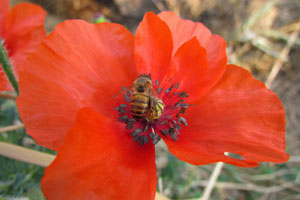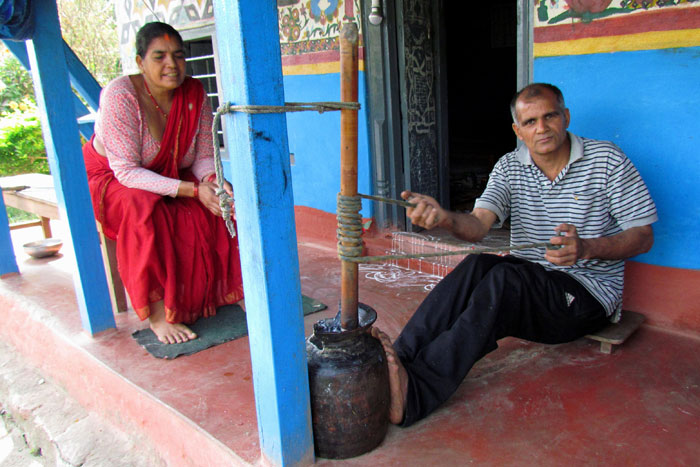Mountain landscapes have long been nurtured by family farmers, and these landscapes, in turn, sustain farmers’ livelihoods. Yet, mountain life is by no means easy. Inaccessible terrain, harsh topography and social and political marginalisation tend to undermine food security. This led farmers in some areas to look at income generation by switching to cash crops. But this caused new problems, as a community in the Nepalese Himalayas discovered, and who have been on a journey from biodiversity to monoculture, and back again.
Grains produced in mountain landscapes may fill the bellies of mountain people for a few months each year, but for the remaining months, farmers have to rely on other sources of food and income, or may have no alternative but to buy grain on the market.
In 1989, cereal production began to decline, due to poor rains, lack of labour and no technological advancement. Subsequent food shortages led farmers to focus on new cash crops for export, and commercial orange farming appeared to offer the best way out of poverty and dependence.
Around 55 household in Chitikhola, Tanahun District, began planting orange trees in 1991, and entire north-facing terraces were soon transformed into orange orchards.
“Prosperity without resilience is temporary at best”
A journey to monoculture…
Citrus decline
The name ‘citrus decline’ is open to confusion as it can be used to refer to several diseases. In Nepal, the name refers to the bacterial disease Liberibacter asiaticus, otherwise known as citrus dieback, Asian greening, yellow dragon, or huanglongbing. It is regarded as one of the most important threats to global citrus production, and by the early 1990s it was estimated that more than 60 million trees had been destroyed worldwide. In Asia, more than 100 million trees have been destroyed, and it continues to spread, with one million trees killed in Brazil in 2004.
For the first years, the results were impressive. Orange farming quickly and significantly improved the economic status of the farmers. In 2006 and 2007, these farmers produced a total of 300 tonnes of oranges, earning US$62,000 between them, or an average of US$521 per individual farmer per year. This was an increase of almost US$150 for each farming family. Every year, the land planted with oranges increased and yields per hectare also increased. However, this prosperity soon came to an abrupt end.
By 2010, in the space of a single year, around 10,000 orange trees were killed by ‘citrus decline’ disease and the whole basis of their newfound wealth and livelihood was destroyed. This left farmers who had become solely dependent on orange production with nothing but devastation, and a whole new set of challenges. The community sought help from the government but was offered little support to compensate them for their huge losses.
In the face of this disaster, farmer and community leader Basu Raj Kadariya put his creativity and intelligence to work to revive the landscape and rebuild a resilient farming system. Having learnt from the catastrophic consequences of relying on a monoculture, he diversified his farming activities to minimise risks. He started by prioritising livestock rearing, small scale vegetable farming and small scale beekeeping, introducing more varied crops, and using forest resources in a more sustainable way.
…and back again
Basu Raj Kadariya developed his farm as a learning center for other small farmers in 2011 soon after the orange orchards were killed. Being a progressive farmer, he took on the responsibility of teaching other poor farmers about new farming techniques and innovations, using seeing-is-believing and learning-by-doing as the best approach. Using his own farm as a learning and demonstration centre, other farmers come to learn new farming skills and crops.
New growing technologies for tomato and cucumber are mostly preferred by these farmers who hope to add extra income for their family. Almost all the farmers in his village have benefitted from his learning center, and besides this, he has directly shared his knowledge and farming innovations to around 160 farmers from other villages who came to visit his farm asking for help. He recently demonstrated how to use drip irrigation for producing tomatoes in plastic greenhouses.
Initially, the community was not confident about how crop diversification could restore their economy and their landscape, especially after their experience with oranges. The selection of the right crops was crucial and famers were cautious after the recent failure of their whole farming enterprise. With their traditional farming knowledge, they began to grow new crops, but their yields were not enough at first to earn an adequate living. However, this allowed them to slowly change their thinking and when they started to grow other vegetables which performed much better, the landscape begin to revive.
Integrating livestock
Livestock, and especially goats, buffalo and poultry offer Nepalese farmers numerous benefits within their diversified farming systems. Goats are affordable but are also a valuable source of ‘insurance’ if crops fail, providing milk, meat and income. Through their grazing and browsing of certain plants, animals also play an important role in maintaining the whole landscape, and help to sustain organic crop production by the manure that they produce.
Farmers in Chitikhola now raise more livestock using traditional practices which involve providing shelter, and nutritious fodder. The presence of sufficient fodder trees within the landscape is a critical factor enabling farmers to keep animals within their farming system.
Tree species being planted include khanyo (Ficus semicordata), tanki (Bauhinia purpuria), and dabdabe (Garuga pinnata), with other fodder plants being bhatmase (Flemengia congesta), napier (Pennisetum purpureum), kutmero (Litsea polyantha) and gideri (Premna barbata).
Crop diversification
Farmers are now reshaping their landscape and rebuilding resilient farming systems not only through integrating livestock but also through crop diversification. Among the various vegetables grown, surplus from some of them such as tomato and cucumber are sold on the local market.
Growing more crop species is far less risky than depending on just one, provides a greater variety of possible income sources and spreads production over more of the year. Farmers have taken control of their own seed production and storage, and this self sufficiency reduces their costs and increases their profits.
Based on recommendations from local extension officers, some high yielding varieties such as the hybrid tomato ‘Shrijana’ have been introduced and are increasingly grown. Beside vegetables, Basu Raj Kadariya, for example, is planting more cardamom on the bunds of terraces, adding yet another income from the sale of this spice while also reducing the risk of erosion.
Agroforestry is another way of diversifying their farms, and farmers have started using some space on their terraces to plant the fodder tree badhar (Artocarpus lakoocha) which further supports the integration of livestock into the landscape. Diversification is an ongoing process and with the help of extension staff, progressive farmers lead the way in exploring options for new crops such as kiwi fruit, with many other farmers now beginning to experiment on their own.
Environmentally friendly methods such as compost, manure and organic mulches are used to feed and protect the soils and the crops, which they have relearned from the days before growing oranges. Others, like botanical pesticides, are new, and their integrated use has become a turning point for developing organic crop production which is leading to healthier agroecosystems.
Botanical pesticides, known as jholmol, are made locally by fermenting local plants such as neem (Azadirachta indica), asuro (Justicia adhatoda), chilli (Capsicum frutescens) and timur (Zanthoxylum armatum) with cattle urine and curd for 45 days. Now, their organic vegetables are highly sought after on the local market as people consider them to have superior taste and quality.
Sustainable use of the forest
Local areas of woodland such as the Bageshwori Community Forest provide fodder, mulches and firewood along with various ecological services, but they also offer additional opportunities. Kadariya worked with the community forest user group that was established in 2009 and includes all the local farmers, to begin shitake mushroom cultivation.
The forest is dominated by tree species like chilaune (Schima wallichii), katus (Castanopsis indica) and sal (Shorea robusta) whose wood is suitable for mushroom cultivation. Small pieces of timber from katus trees and cool temperatures are ideal for growing shitakes. Shitake mushrooms are highly nutritious, have many stated medicinal properties, and fetch a high price on the market. Once spores are inserts into holes in small pieces of timber, it takes about 6-9 months until the first harvest, and production continues for more than five years.
Conservation of the forest areas is also a priority, with groups of farmers planting and conserving young trees, and quotas are agreed and issues to ensure sustainable harvest during regular council meetings which decide the level of sustainable harvests, equitable prices and conservation strategies. For example, each household is allowed to harvest 20 logs for free, after which they must pay US$0.21 (or Rs. 15) per piece.
Beekeeping

Diverse crop and forest species support diverse and healthy bee fauna within the landscape. Apis crerena, a honey bee native to the Himalayan region of Nepal, has been reared by local farmers in small scale hives for many years, but has increased dramatically in recent years. Farmers now keep up to five hives, and produce organic honey for local markets and for sale farther afield.
Honey is considered to be a heavenly food in Nepal and it is an important source of both medicine and nutrition. Beekeeping not only provides food and another source of income to farmers, but the presence of bees also enhances vegetable production through pollination.
The government is also encouraging mountain people to take up beekeeping in a more organised way, as they have realised the benefits from the conservation of forests and crop diversity that lead to more secure livelihoods.
Better than before
Locally adapted practices are being put to work to revive and reshape an entire mountain landscape
This is a story of a community that took action to rebuild their landscape after a disaster caused by a switch to reliance on a monoculture. Well acquainted with hardship and the struggle for food security, farmers in Chitikhola were eager to improve their prospects.
Specialised orange production promised new horizons but the arrival of a new disease that caused a sudden and absolute devastation of their orange orchards changed their landscape.
A leader farmer, Basu Raj Kadariya, was quick to understand that prosperity without resilience is temporary at best. He realised that diversification offered a true pathway towards a better life, and set about to experiment and provide the leadership needed to revive the landscape. Livestock, crop diversification, sustainable use of forest products and beekeeping became complementary elements of a new farming system.
A local learning centre enabled farmers in the community to learn about and experiment with a range of practices on their own farms. Ultimately, local knowledge and creativity resulted in locally adapted practices that are being put to work to revive and reshape an entire mountain landscape.
Sandesh Timilsina
Sandesh Timilsina is completing a degree in agriculture at the Institute of Agriculture and Animal Science in Nepal.
Email: sandeshtimilsina@gmail.com


